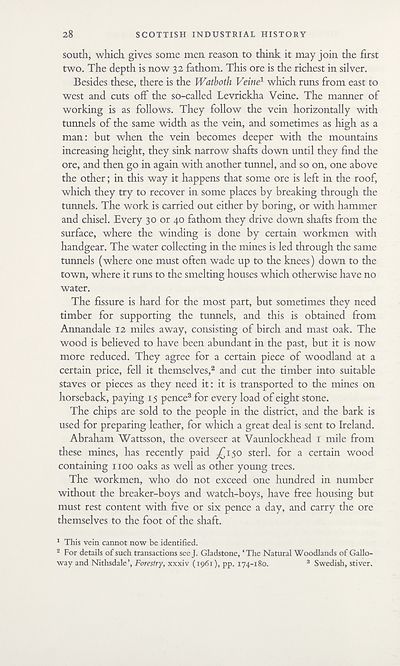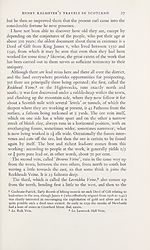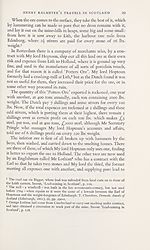Series 4 > Scottish industrial history
(73) Page 28
Download files
Complete book:
Individual page:
Thumbnail gallery: Grid view | List view

28
SCOTTISH INDUSTRIAL HISTORY
south, which gives some men reason to think it may join the first
two. The depth is now 32 fathom. This ore is the richest in silver.
Besides these, there is the Watboth Veine1 which runs from east to
west and cuts off the so-called Levrickha Veine. The manner of
working is as follows. They follow the vein horizontally with
tunnels of the same width as the vein, and sometimes as high as a
man: but when the vein becomes deeper with the mountains
increasing height, they sink narrow shafts down until they find the
ore, and then go in again with another tunnel, and so on, one above
the other; in this way it happens that some ore is left in the roof,
which they try to recover in some places by breaking through the
tunnels. The work is carried out either by boring, or with hammer
and chisel. Every 30 or 40 fathom they drive down shafts from the
surface, where the winding is done by certain workmen with
handgear. The water collecting in the mines is led through the same
tunnels (where one must often wade up to the knees) down to the
town, where it runs to the smelting houses which otherwise have no
water.
The fissure is hard for the most part, but sometimes they need
timber for supporting the tunnels, and this is obtained from
Annandale 12 miles away, consisting of birch and mast oak. The
wood is believed to have been abundant in the past, but it is now
more reduced. They agree for a certain piece of woodland at a
certain price, fell it themselves,2 and cut the timber into suitable
staves or pieces as they need it: it is transported to the mines on
horseback, paying 15 pence3 for every load of eight stone.
The chips are sold to the people in the district, and the bark is
used for preparing leather, for which a great deal is sent to Ireland.
Abraham Wattsson, the overseer at Vaunlockhead 1 mile from
these mines, has recently paid ^150 sterl. for a certain wood
containing 1100 oaks as well as other young trees.
The workmen, who do not exceed one hundred in number
without the breaker-boys and watch-boys, have free housing but
must rest content with five or six pence a day, and carry the ore
themselves to the foot of the shaft.
1 This vein cannot now be identified.
2 For details of such transactions see J. Gladstone, ‘The Natural Woodlands of Gallo¬
way and Nithsdale’, Forestry, xxxiv (1961), pp. 174-180. 3 Swedish, stiver.
SCOTTISH INDUSTRIAL HISTORY
south, which gives some men reason to think it may join the first
two. The depth is now 32 fathom. This ore is the richest in silver.
Besides these, there is the Watboth Veine1 which runs from east to
west and cuts off the so-called Levrickha Veine. The manner of
working is as follows. They follow the vein horizontally with
tunnels of the same width as the vein, and sometimes as high as a
man: but when the vein becomes deeper with the mountains
increasing height, they sink narrow shafts down until they find the
ore, and then go in again with another tunnel, and so on, one above
the other; in this way it happens that some ore is left in the roof,
which they try to recover in some places by breaking through the
tunnels. The work is carried out either by boring, or with hammer
and chisel. Every 30 or 40 fathom they drive down shafts from the
surface, where the winding is done by certain workmen with
handgear. The water collecting in the mines is led through the same
tunnels (where one must often wade up to the knees) down to the
town, where it runs to the smelting houses which otherwise have no
water.
The fissure is hard for the most part, but sometimes they need
timber for supporting the tunnels, and this is obtained from
Annandale 12 miles away, consisting of birch and mast oak. The
wood is believed to have been abundant in the past, but it is now
more reduced. They agree for a certain piece of woodland at a
certain price, fell it themselves,2 and cut the timber into suitable
staves or pieces as they need it: it is transported to the mines on
horseback, paying 15 pence3 for every load of eight stone.
The chips are sold to the people in the district, and the bark is
used for preparing leather, for which a great deal is sent to Ireland.
Abraham Wattsson, the overseer at Vaunlockhead 1 mile from
these mines, has recently paid ^150 sterl. for a certain wood
containing 1100 oaks as well as other young trees.
The workmen, who do not exceed one hundred in number
without the breaker-boys and watch-boys, have free housing but
must rest content with five or six pence a day, and carry the ore
themselves to the foot of the shaft.
1 This vein cannot now be identified.
2 For details of such transactions see J. Gladstone, ‘The Natural Woodlands of Gallo¬
way and Nithsdale’, Forestry, xxxiv (1961), pp. 174-180. 3 Swedish, stiver.
Set display mode to:
![]() Universal Viewer |
Universal Viewer | ![]() Mirador |
Large image | Transcription
Mirador |
Large image | Transcription
Images and transcriptions on this page, including medium image downloads, may be used under the Creative Commons Attribution 4.0 International Licence unless otherwise stated. ![]()
| Scottish History Society volumes > Series 4 > Scottish industrial history > (73) Page 28 |
|---|
| Permanent URL | https://digital.nls.uk/126655887 |
|---|
| Description | Over 180 volumes, published by the Scottish History Society, containing original sources on Scotland's history and people. With a wide range of subjects, the books collectively cover all periods from the 12th to 20th centuries, and reflect changing trends in Scottish history. Sources are accompanied by scholarly interpretation, references and bibliographies. Volumes are usually published annually, and more digitised volumes will be added as they become available. |
|---|


